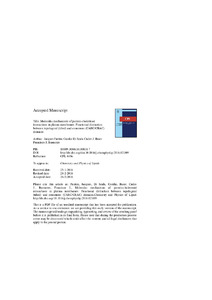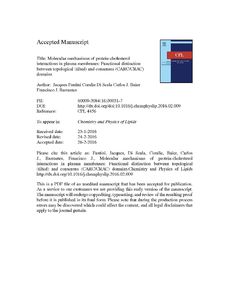Por favor, use este identificador para citar o enlazar este ítem:
https://repositorio.uca.edu.ar/handle/123456789/8789| Título: | Molecular mechanisms of protein-cholesterol interactions in plasma membranes : functional distinction between topological (tilted) and consensus (CARC/CRAC) domains | Autor: | Fantini, Jacques Di Scala, Coralie Baier, Carlos J. Barrantes, Francisco José |
Palabras clave: | AMINOACIDOS; COLESTEROL; LIPIDOS; PROTEINAS; MEMBRANA CELULAR | Fecha de publicación: | 2016 | Editorial: | Elsevier | Cita: | Fantini J, Di Scala C, Baier CJ, Barrantes FJ. Molecular mechanisms of protein-cholesterol interactions in plasma membranes : functional distinction between topological (tilted) and consensus (CARC/CRAC) domains [en línea]. Chemistry and Physics of Lipids. 2016;199:52-60. doi:10.1016/j.chemphyslip.2016.02.009 Disponible en: https://repositorio.uca.edu.ar/handle/123456789/8789 | Resumen: | Abstract: The molecular mechanisms that control the multiple possible modes of protein association with membrane cholesterol are remarkably convergent. These mechanisms, which include hydrogen bonding, CH-π stacking and dispersion forces, are used by a wide variety of extracellular proteins (e.g. microbial or amyloid) and membrane receptors. Virus fusion peptides penetrate the membrane of host cells with a tilted orientation that is compatible with a transient interaction with cholesterol; this tilted orientation is also characteristic of the process of insertion of amyloid proteins that subsequently form oligomeric pores in the plasma membrane of brain cells. Membrane receptors that are associated with cholesterol generally display linear consensus binding motifs (CARC and CRAC) characterized by a triad of basic (Lys/Arg), aromatic (Tyr/phe) and aliphatic (Leu/Val) amino acid residues. In some cases, the presence of both CARC and CRAC within the same membrane-spanning domain allows the simultaneous binding of two cholesterol molecules, one in each membrane leaflet. In this review the molecular basis and the functional significance of the different modes of protein-cholesterol interactions in plasma membranes are discussed. | URI: | https://repositorio.uca.edu.ar/handle/123456789/8789 | ISSN: | 0009-3084 (impreso) 1873-2941 (online) |
Disciplina: | MEDICINA | DOI: | 10.1016/j.chemphyslip.2016.02.009 | Derechos: | Acceso abierto. 12 meses de embargo | Fuente: | Chemistry and Physics of Lipids. 2016;199:52-60 |
| Aparece en las colecciones: | Artículos |
Ficheros en este ítem:
| Fichero | Descripción | Tamaño | Formato | |
|---|---|---|---|---|
| molecular-mechanisms-protein-cholesterol.pdf | 1,3 MB | Adobe PDF |  Visualizar/Abrir | |
| molecular-mechanisms-protein-cholesterol.jpg | 259,88 kB | JPEG |  Visualizar/Abrir |
Visualizaciones de página(s)
270
comprobado en 19-dic-2025
Descarga(s)
657
comprobado en 19-dic-2025
Google ScholarTM
Ver en Google Scholar
Altmetric
Altmetric
Este ítem está sujeto a una Licencia Creative Commons

